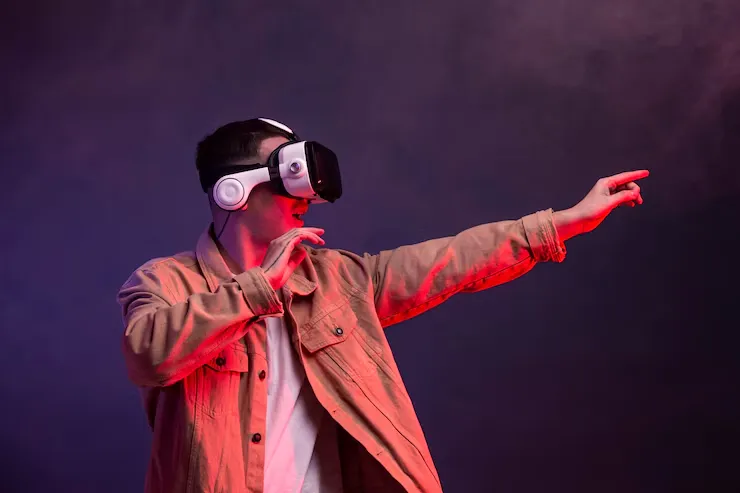In today’s tech-driven world, Virtual Reality Fitness Programs have become more than a trend—they’re a revolution in how we train, sweat, and succeed. These programs combine cutting-edge technology with physical activity to create immersive workout experiences that are as engaging as they are effective. Whether you’re grinding for success at home or pushing your limits in a digital gym, virtual reality fitness programs offer an entirely new dimension to personal wellness.
1. What Are Virtual Reality Fitness Programs?
Redefining the Way We Move
Virtual reality fitness programs are exercise systems that use VR headsets and motion-tracking technology to simulate realistic workout environments. Users can box in a digital ring, jog through scenic landscapes, or take part in interactive HIIT classes—all from the comfort of their living room.
Unlike traditional workouts, these experiences boost motivation by combining VR exercise regimens with gamified rewards, real-time feedback, and dynamic challenges. Moreover, the fully immersive workout experiences make it easier to stay consistent without feeling bored or distracted.
2. Why Virtual Reality Fitness Programs Work
The Psychology Behind the Sweat
What sets virtual reality fitness programs apart is how they engage your brain while exercising your body. You’re no longer staring at a wall while running on a treadmill—you’re racing through forests, dodging enemies, or participating in group dance sessions. This stimulation activates dopamine and serotonin release, making you feel accomplished and entertained.
These programs are perfect for people who want fast results, improved mental health, and the convenience of skipping the gym. No more excuses—your next workout is just a headset away.
3. Benefits of Using Virtual Reality Fitness Programs
Fitness Made Fun and Accessible
- Convenience: No commute, no crowds. Exercise at any hour.
- Variety: From boxing and cardio to meditation and yoga.
- Motivation: Gamification keeps users coming back.
- Performance Tracking: Real-time stats help track your grind success.
- Privacy: Workout in your own space without judgment.
The benefits go beyond physical transformation—they include mental clarity and stress reduction through augmented reality training sessions and mindfulness-based VR classes.
4. Best Devices for Virtual Reality Fitness Programs
Choosing the Right Gear
To experience the full potential of virtual reality fitness programs, you need the right tech setup. The most popular VR fitness devices include:
- Meta Quest 2 / 3 – Lightweight, wireless, and perfect for workouts
- HTC Vive – Great for high-quality visuals and tracking
- PlayStation VR2 – Ideal for console-based fitness fans
Pair these with fitness apps like Supernatural, FitXR, or Les Mills BodyCombat for a premium VR experience.
5. Virtual Reality Fitness vs. Traditional Workouts
Which One Delivers More Results?
Traditional workouts have their strengths—tried-and-tested techniques, access to equipment, and real-time trainers. However, virtual reality fitness programs provide something most gyms can’t: sustained engagement.
In fact, users report higher adherence rates to VR workouts than traditional gym routines. When you’re swinging a lightsaber or dancing in rhythm, the session doesn’t feel like work—it feels like play, with all the physical benefits included.
6. Tips for Maximizing Your VR Workout
How to Grind for Success the Smart Way
- Set Goals: Define your fitness objectives before starting.
- Mix It Up: Use multiple apps to avoid plateaus.
- Stay Safe: Ensure ample space and use protective gear.
- Track Progress: Most apps let you monitor heart rate, calories, and time.
- Hydrate: VR may trick your mind, but your body still sweats!
Following these tips ensures that virtual reality fitness programs become a consistent part of your wellness routine—not just a novelty.
7. Future of Virtual Reality Fitness Programs
Where Technology Meets Wellness
As VR tech evolves, virtual reality fitness programs will become even more immersive, interactive, and AI-integrated. Expect personalized fitness coaches, holographic workout partners, and adaptive difficulty levels based on biometric feedback.
Companies are already exploring ways to blend VR exercise regimens with augmented nutrition tracking, mental wellness tools, and sleep optimization, pushing the limits of what fitness can offer.
8. Who Should Use Virtual Reality Fitness Programs?
The Universal Appeal of VR Workouts
From beginners to seasoned athletes, anyone can benefit from VR workouts:
- Busy professionals seeking home workout convenience
- Teens and young adults who thrive on tech-based experiences
- Seniors who want gentle guided movement
- Gamers looking to add physical benefits to their screen time
Whether you’re aiming for better health, stronger muscles, or improved cardio, virtual reality fitness programs adapt to every level and lifestyle.
Top 8 FAQs about Virtual Reality Fitness Programs
1. Are virtual reality fitness programs effective for weight loss?
Yes, consistent use can help burn calories, improve cardiovascular health, and support weight management.
2. Do I need special equipment for VR fitness?
A VR headset and compatible apps are required. Some workouts may need controllers or motion sensors.
3. Is it safe to exercise using VR?
Yes, but ensure your workout area is clear of obstacles, and always follow app safety guidelines.
4. Can children use VR fitness programs?
Yes, but it’s recommended for ages 13+ with adult supervision.
5. What are some popular VR fitness apps?
FitXR, Supernatural, Thrill of the Fight, and Beat Saber are among the top-rated.
6. How long should a VR workout be?
Sessions typically range from 15 to 45 minutes, depending on intensity and goals.
7. Can I build muscle with VR fitness?
Yes, especially when incorporating resistance bands or bodyweight training apps.
8. Are virtual reality fitness programs subscription-based?
Many top apps require a monthly subscription, though free trials and budget options exist.



